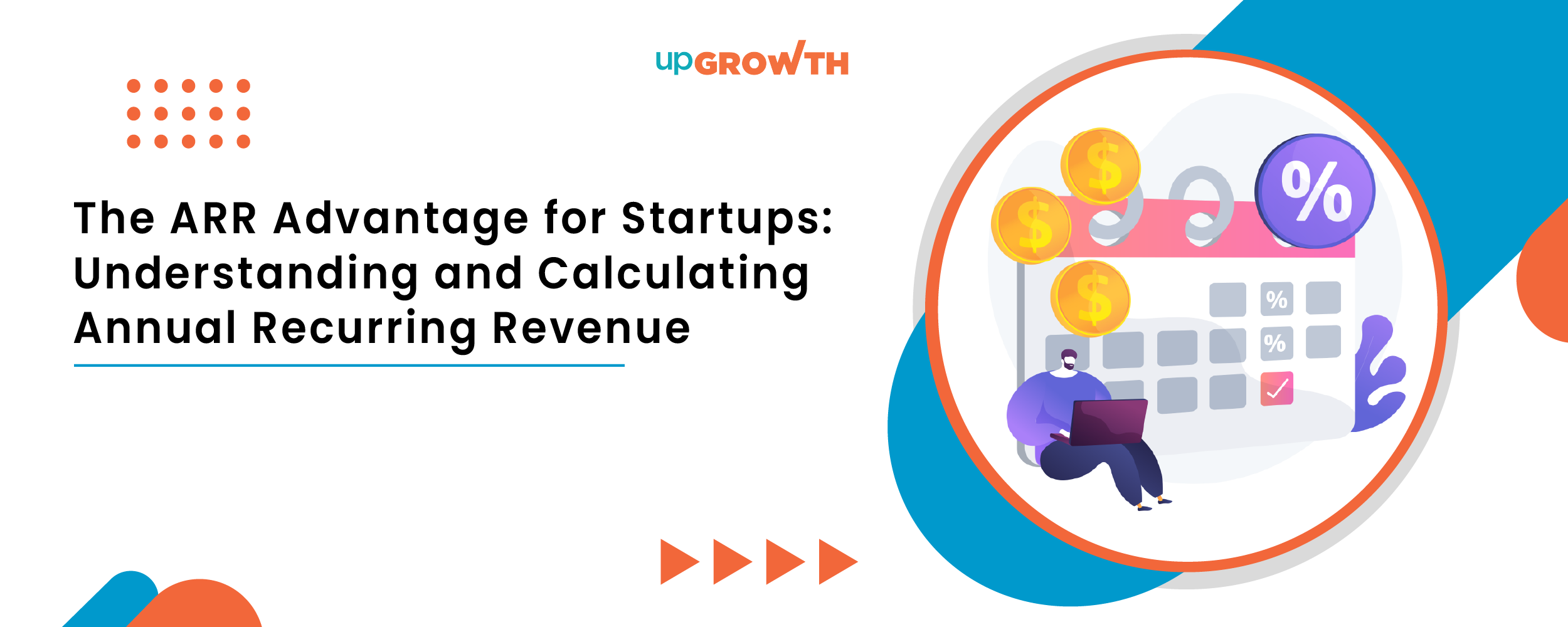The ARR Advantage for Startups: Understanding and Calculating Annual Recurring Revenue
Contributors:
Amol Ghemud
Published: December 23, 2022

Introduction to ARR for Startups
The arr calculation is essential for all startups; ARR or Annual Recurring Revenue is one of the critical matrices that calculate the percentage rate of return that a business can expect over the life of an investment or asset in any financial year period. Fundamentally, ARR calculation is the predictable revenue that a company earns annually from its customers.
Every business looks forward to growing its ARR occasionally, and a decrease in the ARR of a particular segment means that the industry has to rethink its strategy. The starters need to keep the revenue model subscription-based rather than a one-time purchase. Be it investors or the company’s management, ARR remains a crucial metric for all.
Accepting a particular project depends on whether the result is more significant or equal to the desired ARR. ARR is known to be one of the widespread financial ratios and makes the decision-making process simple while comparing and selecting different projects. However, for long-term capital investments, ARR is sufficient as it does not consider the taxes, interest that occurred, etc.
How to calculate ARR?
The customer payback period for Annual Recurring Revenue (ARR) measures the time it takes for a customer to recover the total cost of their subscription or recurring payments through the value they receive over a year.
For some, ARR calculation is a straightforward metric for a business over 12 months. Nonetheless, ARR calculation depends on numerous factors that contextualize the overall growth of the business and can vary from company to company. ARR also includes the complexity and the pricing strategy of the business model.
The annual net profit of an investment can be calculated as revenue minus annual expenses that occurred during the project implementation.
For fixed asset investments, like property, one needs to work out the depreciation expense from the annual revenue figure.
Lastly, one needs to divide the annual net profit by the initial investment or cost of the project and multiply the result by 100 to get the percentage value.
The CAC (Customer Acquisition Cost) payback calculation for Annual Recurring Revenue (ARR) analyzes the timeframe in which a business can recover its customer acquisition expenses through the revenue generated from annual subscriptions.
Simply put, Annual Recurring Revenue (ARR) can be calculated as follows:
Average Annual Profit to Initial Investment = Annual Recurring Revenue (ARR)
ARR is widely done to get a guide of how attractive the investment is and typically consists of only fixed and committed recurring fees or subscriptions. There are no specified rules for the determination of ARR. However, ARR may differ depending on a business’s contract term. Annual recurring value is essential as it helps companies get a brief insight into how flourishing their regular revenue growth is.
Calculating the customer payback period for ARR allows businesses to evaluate the profitability and sustainability of their subscription-based model, helping them assess how long it takes for customers to achieve a positive return on their annual investment.
Importance of ARR Calculation
Annual Recurring Revenue is highly advantageous as it decides the project’s profitability. Small-time investors often use this method to appraise their investment decision, enabling them to compare various projects. The best part about ARR is that it makes it relatively easy to understand the payback period by calculating the total savings over the project., enabling.
The payback period formula for Annual Recurring Revenue (ARR) calculates the time it takes for a business to recover its initial investment in customer acquisition costs through the revenue generated from annual subscriptions.
The Accounting Rate of Return is the most straightforward calculation to determine a particular project’s annual percentage rate of return. Usually, ARR calculation is more than just limited before accepting the proposal but is done year-to-year to keep a close eye on the returns from a specific project. If the manager notices that the minimum required return of the project is more significant than ARR, they will not go ahead with the project.
The CAC payback period formula for Annual Recurring Revenue (ARR) measures the time a business recoups its customer acquisition costs through the revenue generated from annual subscriptions.
The payback period formula for ARR is determined by dividing the total customer acquisition costs by the annual recurring revenue, providing valuable insights into the timeline for achieving a positive return on investment.
The advantages of arr its baseline where businesses can build more complex calculations. With the help of ARR, a company can create a reasonable picture of what the future would look like to them.
ARR is a magical metric that blesses businesses with a valuable context for future decisions. With it, one will find it easier to understand the real customer impact of the choices that they make for their business.
Closure
The Accounting Rate of Return remains a crucial metric for any business with a subscription model. The overall health of the business or the company concerning the actions that can be taken to increase or decrease the growth momentum is concluded by ARR. An increase in recurring revenue, in turn, helps the businesses create a better and thriving team to create the best products in the future.
The CAC payback period formula for ARR calculation divides the total customer acquisition costs by the annual recurring revenue, giving businesses insights into the timeframe for recovering their initial investment.
FAQs
1. How do you calculate an ARR?
Simply put, there are two ways to calculate an ARR:
One is the most straightforward way: add all the expected recurring value they may receive over a year.
The other one is to use the ARR formula, which considers various lengths of time customers have subscribed. This method paves the way for more accuracy, but the catch is that the overall calculation takes more time and information.
ARR Calculation formula:
ARR = Total revenue in a year for new subscriptions + Recurring revenue from existing subscriptions at the beginning of the year
2. ow do you calculate ARR growth?
ARR growth rate helps businesses gain an insight into the speed at which a company or a firm is growing, along with identifying the potential that might come in their journey. The growth rate for SaaS businesses can be calculated by measuring the change in Annual Recurring Revenue (ARR) over time. The primary and first metric that one will refer to while calculating a company’s growth rate is the change in revenue over time.
3. What is ARR?
The accounting rate of return (ARR) formula represents the expected percentage rate of return on an asset or investment in relation to the initial investment cost.
4. How is ARR calculated?
ARR is calculated using the following straightforward formula: ARR = (Sum of subscription revenue for the year + recurring revenue from add-ons and upgrades) – revenue lost from cancellations and downgrades that year.
5. How is MRR calculated?
Calculating MRR is simple. Just multiply the monthly subscribers by the average revenue per user (ARPU). When calculating MRR for subscribers under annual plans, the annual plan price is divided by 12, and the result is multiplied by the number of consumers on the annual plan.
6. Why is ARR important?
ARR facilitates measuring business development and forecasting future growth because it represents the revenue a company anticipates repeating. It’s also a helpful indicator for gauging the momentum of new sales, renewals, and upgrades and the momentum lost to things like downgrades and lost clients.
7. What are some limitations of using ARR as a metric?
ARR provides the expected rate of return from each project and is frequently used when evaluating multiple projects. ARR has several drawbacks, one of which is that it needs to distinguish between investments that produce various cash flows over the course of the project.
8. What is the LTV CAC payback period?
The LTV CAC payback period refers to the time it takes for a business to recover its customer acquisition costs (CAC) through the lifetime value (LTV) generated from those customers.
Other Startup KPI Metrics
Understanding and Maximizing Monthly Recurring Revenue
Using ACV to Measure the Success of Your Sales and Marketing Efforts
Total Contract Value – A Key Metric for Evaluating Business Performance
Why Customer Lifetime Value Is the Most Crucial Metric for Your Business
The Importance of Accurately Calculating Deferred Revenue
Maximizing User Retention: How to Calculate Daily Active Users
Compounded Monthly Growth Rate: Understanding and Calculating Compounded Monthly Growth Rates
Calculating Your Company’s Total Addressable Market (TAM): A Step-by-Step Guide
Measuring Monthly Recurring Revenue: Expert Tips and Advice
Maximizing the Efficiency of Your Billing Process in Accounting
About the Author
Optimizer in Chief
Amol has helped catalyse business growth with his strategic & data-driven methodologies. With a decade of experience in the field of marketing, he has donned multiple hats, from channel optimization, data analytics and creative brand positioning to growth engineering and sales.
 Growth Strategy and Planning
Growth Strategy and Planning Inbound Growth
Inbound Growth Growth Hacking
Growth Hacking Search Engine Optimization
Search Engine Optimization Paid and Performance Marketing
Paid and Performance Marketing Social Media Marketing
Social Media Marketing AI-Driven Growth Strategy
AI-Driven Growth Strategy
 Growth Tools
Growth Tools Offers
Offers


















Leave a Reply